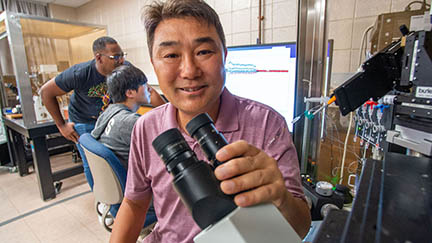by Tim Crosby
CARBONDALE, Ill. – A researcher at Southern Illinois University Carbondale is trying to find ways to better understand and control the inflammation process, an important biological dynamic in human health.

Chilman Bae, assistant professor in the School of Electrical, Computer, and Biomedical Engineering, recently received a $200,000 Engineering Research Initiative grant from the National Science Foundation to look into mechanobiological ion channels, a subset of proteins that translate mechanical signals into biochemical responses in the body. The two-year grant will cover salaries for Bae and two doctoral students, as well as essential laboratory supplies.
Bae said the project’s findings could offer potential therapeutic approaches to inflammation.
“We are trying to reveal the intricate mechanisms that control and regulate inflammation,” he said. “We aim to provide valuable insights.”
Inflammation’s impact
Medical science is highly interested in inflammation and the role it plays – both good and bad – in human health.
A natural response to injury, stress and illness, inflammation can play a vital role in healing and recovery. But it also can lead to discomfort – through processes such as swelling and fever – and overabundance of inflammation can lead to serious and chronic illness, impacting even nervous system senses such as hearing and touch.
Over-the-counter medicines such as naproxen and ibuprofen can provide relief from the unpleasant side effects of minor inflammation, but researchers have further turned their attention to chronic inflammation, studying pathways known as mechanosensitive ion channels and how changing them in response to a mechanical stimulus might impact that area.
Important pathways
Bae is focusing particularly on finding ways to safely chemically modulate the mechanosensitive ion channels called Piezo1 and Piezo2, which play key roles in touch, hearing and causing diseases. Such modulators, which include biochemicals that activate or inhibit reactions, might hold the key to preventing inflammation-related hearing loss, for example.
Some of the parts of the puzzle may lie in common foods, he said.
“Our objective is to find out if a fundamental amino acid prevalent in meat, fish and dairy can regulate the Piezo channel,” Bae said. “That channel potentially exerts a vital role in nervous system inflammation regulation.”
Scientists previously learned of an activator modulator known as Yoda1. But its toxicity makes it impossible to administer orally. Bae is investigating an innovative modulator that can overcome that issue.
“The challenge is to find selective modulators for these channels that are safe for human use,” Bae said. “Our project aims to identify and characterize this new Piezo1 modulator and then develop techniques for studying mechanosensitive channels.”
A key type of cell
Another aspect of the research involves creating an astrocyte cell model for inflammation in order to learn more about its underlying mechanism. Astrocytes not only regulate blood flow but also transfer mitochondria to neurons and supply the building blocks of neurotransmitters that in turn power neuronal metabolism and attack infections in nerve synapses.
“This work is aimed at providing a therapeutic framework for inflammation treatment and contributing to research and education in neuroscience, developmental biology and immunology,” Bae said.
Working in the laboratory, Bae and his students will examine the impact of modulators, looking at both the biophysical characteristics of Piezo1 and inflammation using in-vitro electrophysiological recordings, wound-healing experiments and calcium imaging.
